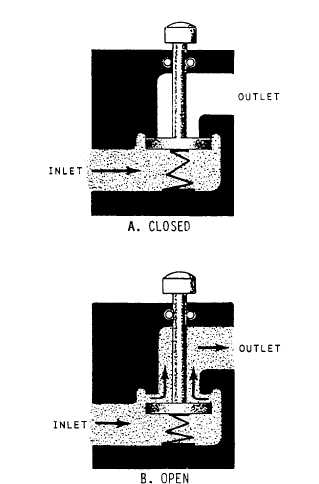the regulator ball and provides the pump with an unrestricted fluid flow back to the reservoir.
In figure 10-19 the regulator ball is unseated. When this happens, pressure drops immediately. Now the importance of the check valve can be seen. With the sudden reduction in pressure, the check valve snaps shut; and the fluid trapped in the system line continues to hold the regulator piston in the raised position. This trapped fluid also maintains pressure on the system until the mechanism actuates or is relieved by leakage, either of which can cause the regulator to cut-in.
Hydraulic systems using a constant volume pump require a pressure regulator valve; those using a variable volume pump do not.
Selector Valves
The purpose of a selector valve is to control direction of fluid flow; this, in turn, controls the the operation or direction of the mechanism. Although all selector valves share the common purpose of controlling the direction of fluid flow, they vary considerably in physical characteristics and operation.
The valving element of these units may be one of three types: the poppet type, in which a piston or ball moves on and off a seat; the rotary sped type, in which the spool rotates about its axis; or the sliding spool type, in which the spool slides axially in a bore. Selector valves may be actuated mechanically, manually, electrically, hydraulically, or pneumatically.
POPPET VALVE. - Figure 10-20 illustrates the operation of a simple poppet valve. The valve consists primarily of a movable poppet that closes against a valve seat. In the closed position, fluid pressure on the inlet side tends to hold the valve tightly closed. A small amount of movement from a force applied to the top of the poppet stem opens the poppet and allows fluid to flow through the valve.
The poppet, usually made of steel, fits into the center bore of the seat. The seating surfaces of the poppet and the seat are lapped or closely machined, so the center bore will be sealed when the poppet is seated. The action of the poppet is similar to the valves of an automobile engine. An O-ring seal is usually installed on the stem of the poppet to prevent leakage past this portion of the housing. In most valves the poppet is held in the seated position by a spring. The number of poppets in a particular valve depends upon the design and purpose of the valve.
ROTARY SPOOL VALVE. - The rotary spool type of directional control valve has a round core with one or more passages or recesses in it. The core is mounted within a stationary sleeve (fig. 10-21). As the core is rotated (generally by a hand lever or a knob) within the stationary sleeve, the passages or recesses connect or block the ports in the sleeve. The ports in the sleeve are connected to the appropriate pressure, working and return lines of the fluid power system.
SLIDING SPOOL VALVE. - The sliding spool valve is probably the most common type of valving element used in directional control valves. The operation of a simple sliding spool directional control valve is illustrated in figure 10-22. The valve is so named because the shape of the valving element resembles that of a spool and because the valving element slides back and forth to block and uncover ports in the housing.
The valve is shown in neutral position (no fluid flow); but by moving the spool valve to the left position,

Figure 10-20.-The basic operation of a simple poppet valve.
Continue Reading